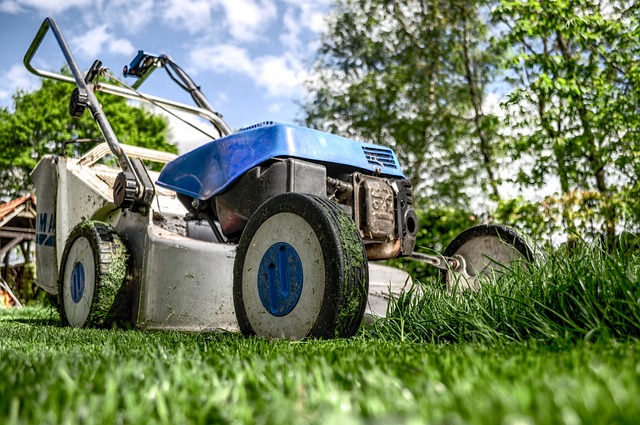Yard Waste Removal and Recycling is a sustainable approach that significantly benefits the environment by reducing greenhouse gas emissions, specifically methane from landfills, and enriching soil health through composting. This practice conserves water, minimizes reliance on synthetic fertilizers, and supports biodiversity by fostering ecosystems that benefit pollinators, birds, and beneficial insects. Embracing sustainable yard maintenance, including mulching to conserve moisture and prevent soil compaction, aligns with broader environmental objectives such as resource conservation and reduced carbon footprints. Xeriscaping, a water-conserving landscaping choice using native plants, further supports these goals by requiring minimal additional water once established. Yard Waste Removal and Recycling complements xeriscaping by transforming organic waste into compost or mulch, creating a self-sustaining landscape with long-term benefits. Communities that implement Yard Waste Removal and Recycling programs not only reap environmental rewards but also strengthen community ties by sharing knowledge and resources for sustainable practices, thereby promoting a collective commitment to ecological health. These initiatives underscore the importance of community action in advancing sustainability and preserving our natural environment.
Embark on a green journey through your yard’s maintenance, where each rake and trim transforms into a pivotal act in sustainable living. This article explores the critical role of eco-conscious yard care, detailing how composting organic waste, mulching for soil health, implementing xeriscaping, and leveraging yard waste removal and recycling programs can significantly contribute to environmental conservation. Dive into the practices that promote resource efficiency, biodiversity, and community connection, making your garden not just a space of beauty but also a testament to responsible stewardship of our planet.
- Understanding the Role of Yard Maintenance in Sustainable Living
- Composting Organic Yard Waste: A Guide to Eco-Friendly Disposal
- The Benefits of Mulching for Soil Health and Resource Conservation
- Implementing Xeriscaping to Reduce Water Usage and Enhance Biodiversity
- Utilizing Yard Waste Recycling Programs to Foster Community and Environmental Well-being
Understanding the Role of Yard Maintenance in Sustainable Living

Maintaining a yard with a focus on sustainability encompasses a range of practices that support environmental health while also contributing to the well-being of the community. Yard maintenance plays a pivotal role in sustainable living by promoting biodiversity, conserving water, and reducing the carbon footprint associated with garden upkeep. One key aspect of this is the proper management of yard waste, which includes organic materials like grass clippings, leaves, and brush. Traditional yard waste removal practices often involve disposal at landfills, where these materials can decompose anaerobically, producing methane, a potent greenhouse gas. However, by engaging in yard waste recycling, homeowners can significantly mitigate the environmental impact of garden maintenance. Composting organic matter not only recycles nutrients back into the soil but also creates a valuable product that enhances soil fertility and reduces the need for chemical fertilizers. Additionally, many municipalities offer yard waste collection programs that convert organic yard waste into compost or mulch, which can then be returned to the community for use in gardens and public green spaces. By adopting sustainable yard maintenance practices and utilizing yard waste removal and recycling services, individuals can contribute to a healthier planet while also creating a more resilient local ecosystem. This holistic approach to yard care ensures that landscapes are not only beautiful but also functional, supporting the natural cycle of nutrients and reducing the need for external inputs.
Composting Organic Yard Waste: A Guide to Eco-Friendly Disposal

Managing yard waste sustainably is crucial for maintaining ecological balance and reducing environmental impact. Traditional yard waste removal methods often involve collecting organic materials such as leaves, grass clippings, and garden trimmings and disposing of them in landfills. However, these practices can contribute to methane emissions as organic matter decomposes anaerobically. A more eco-conscious approach is composting, which not only recycles nutrients back into the soil but also helps reduce the need for chemical fertilizers. Composting is a natural process that transforms organic yard waste into valuable humus, enriching the soil’s structure and fertility. To begin composting, select an appropriate site near a water source with good drainage and air circulation. Ensure that you have a balanced mix of ‘greens’ (nitrogen-rich materials like grass clippings and kitchen scraps) and ‘browns’ (carbon-rich materials such as leaves, straw, and shredded paper). Regularly turn the compost pile to aerate it and maintain moisture levels for optimal decomposition. Monitor the temperature and moisture level of your compost to ensure it remains at an ideal balance for microbial activity, which is key to breaking down organic matter effectively. Yard waste removal and recycling through composting not only provide a cost-effective alternative to traditional disposal methods but also contribute to creating healthy, fertile soil and reducing greenhouse gas emissions. Embracing this sustainable practice can significantly lessen the environmental footprint of yard maintenance while providing a bountiful resource for gardening and landscaping.
The Benefits of Mulching for Soil Health and Resource Conservation

Mulching is a key practice in sustainable yard maintenance, offering significant benefits for soil health and resource conservation. By applying organic materials such as leaves, grass clippings, and other yard waste to the soil surface, mulching creates a protective cover that conserves moisture, moderates soil temperature, and reduces weed germination, thereby promoting a healthier lawn and garden. This process also facilitates the decomposition of organic matter, which in turn enhances soil fertility by adding valuable nutrients back into the soil. The use of yard waste removal and recycling programs is crucial in sourcing these organic materials; these programs transform what would otherwise be discarded waste into beneficial mulch, effectively reducing landfill usage and minimizing methane emissions from decomposing organic matter. This approach not only supports soil health but also aligns with broader environmental goals by conserving resources and reducing the carbon footprint associated with yard maintenance activities.
Furthermore, employing a strategic mulching approach can significantly improve water retention in the soil, reducing the need for supplemental irrigation. This is particularly valuable during periods of drought or high evaporation rates. Additionally, by maintaining a consistent layer of mulch, gardeners can help prevent soil compaction, which is detrimental to root growth and overall plant health. The practice of yard waste removal and recycling not only supports these environmental benefits but also fosters community engagement through the collective effort of repurposing organic materials. This holistic approach to yard maintenance with mulching underscores the importance of integrating sustainability into everyday landscaping practices.
Implementing Xeriscaping to Reduce Water Usage and Enhance Biodiversity

In recent years, homeowners have increasingly turned to xeriscaping as a sustainable solution for yard maintenance, with the dual benefits of reducing water usage and fostering biodiversity. Xeriscaping involves landscaping with drought-resistant plants and requiring minimal supplemental water once established. This approach not only conserves water—a critical resource in many regions—but also creates a diverse ecosystem that supports a wide array of wildlife. By selecting native species, which are naturally adapted to the local climate, these gardens can thrive with rainfall alone. This shift towards xeriscaping is complemented by yard waste removal and recycling programs, which are essential for maintaining the health of ecosystems and preventing pollution. These programs ensure that organic matter like grass clippings and fallen leaves are composted or mulched rather than discarded, thereby returning nutrients to the soil and reducing the need for chemical fertilizers. This holistic approach to yard maintenance not only contributes to water conservation but also promotes a more sustainable and resilient landscape that benefits both the environment and the community.
Furthermore, adopting xeriscaping principles encourages homeowners to make informed choices about the plants they introduce into their yards, which can enhance local biodiversity. By providing habitats for pollinators, birds, and other beneficial insects, these gardens contribute to the ecological balance of the area. The integration of xeriscaping with effective yard waste removal and recycling initiatives underscores the importance of circular sustainability practices. These practices not only reduce the environmental footprint of gardening but also create a self-nourishing ecosystem that requires less intervention and upkeep over time. As such, homeowners looking to implement sustainable yard maintenance practices would do well to consider xeriscaping as a viable and beneficial option for their landscapes.
Utilizing Yard Waste Recycling Programs to Foster Community and Environmental Well-being

Participating in Yard Waste Removal and Recycling programs is a multifaceted approach to environmental stewardship that also fosters community engagement. These initiatives not only divert organic matter from landfills but also enrich the soil, reduce greenhouse gas emissions, and promote biodiversity. By composting yard waste, communities can create a nutrient-rich material that supports plant growth and contributes to healthier ecosystems within local gardens and public spaces. This process turns what was once viewed as waste into a valuable resource, thereby reducing the need for synthetic fertilizers and their associated environmental impacts. Moreover, Yard Waste Removal and Recycling programs often serve as hubs for community interaction, where residents can exchange gardening tips, share compostable materials, and collaborate on local green projects. These efforts encourage a sense of shared responsibility for the environment, fostering a collective ethos that extends beyond individual yards to encompass broader environmental well-being. Engaging with such programs not only supports sustainable practices but also creates opportunities for neighbors to connect, learn from each other, and collectively contribute to the health of their local environment.
In conclusion, yard maintenance is more than a chore; it’s a pivotal aspect of sustainable living that can significantly benefit both our communities and the environment. By composting organic waste, we not only enrich our soils but also minimize methane emissions from landfills. Mulching offers an additional layer of soil health protection while conserving resources. The adoption of xeriscaping practices, which focus on drought-resistant plants and efficient water use, can markedly reduce water consumption and expand biodiversity within our yards. Moreover, participating in yard waste removal and recycling programs is a community-driven approach that fosters environmental stewardship. Integrating these strategies into our routine yard maintenance not only promotes sustainability but also creates healthier, more resilient landscapes for generations to come.






